Design Optimization of a THz Receiver Based on 60 nm Complementary Metal–Oxide–Semiconductor Technology
Abstract
:1. Introduction
2. Materials and Methods: Analysis of the Detection Process
2.1. Electrostatic Potential
2.2. Self-Mixing Voltage
2.3. Displacements of Carriers
3. Receiver Design
3.1. Analysis of the Detector/LNA Coupling
3.2. The Antenna Design
3.3. Analysis of the Antenna–Rectifier Coupling
3.4. The Receiver Optimization
4. Conclusions
Author Contributions
Funding
Data Availability Statement
Conflicts of Interest
References
- Guerboukha, H.; Nallappan, K.; Skorobogatiy, M. Toward real-time terahertz imaging. Adv. Opt. Photonics 2018, 10, 843–938. [Google Scholar] [CrossRef]
- Islam, M.S.; Cordeiro, C.M.; Franco, M.A.; Sultana, J.; Cruz, A.L.; Abbott, D. Terahertz optical fibers. Opt. Express 2019, 28, 16089–16117. [Google Scholar] [CrossRef]
- Zaytsev, K.I.; Dolganova, I.N.; Chernomyrdin, N.V.; Katyba, G.M.; Gavdush, A.A.; Cherkasova, O.P.; Reshetov, I.V. The progress and perspectives of terahertz technology for diagnosis of neoplasms: A review. J. Opt. 2019, 22, 013001. [Google Scholar] [CrossRef]
- Smolyanskaya, O.A.; Chernomyrdin, N.V.; Konovko, A.A.; Zaytsev, K.I.; Ozheredov, I.A.; Cherkasova, O.P.; Coutaz, J.L. Terahertz biophotonics as a tool for studies of dielectric and spectral properties of biological tissues and liquids. Prog. Quantum Electron. 2018, 62, 1–77. [Google Scholar] [CrossRef]
- Yachmenev, A.E.; Lavrukhin, D.V.; Glinskiy, I.A.; Zenchenko, N.V.; Goncharov, Y.G.; Spektor, I.E.; Ponomarev, D.S. Metallic and dielectric metasurfaces in photoconductive terahertz devices: A review. Opt. Eng. 2019, 59, 061608. [Google Scholar] [CrossRef]
- Yachmenev, A.E.; Pushkarev, S.S.; Reznik, R.R.; Khabibullin, R.A.; Ponomarev, D.S. Arsenides-and related III-V materials-based multilayered structures for terahertz applications: Various designs and growth technology. Prog. Cryst. Growth Charact. Mater. 2020, 66, 100485. [Google Scholar] [CrossRef]
- Lepeshov, S.; Gorodetsky, A.; Krasnok, A.; Rafailov, E.; Belov, P. Enhancement of terahertz photoconductive antenna operation by optical nanoantennas. Laser Photonics Rev. 2017, 11, 1600199. [Google Scholar] [CrossRef]
- Pfeiffer, U.R.; Kutaish, A. Terahertz Light-Field Imaging with Silicon Technologies. IEEE Open J. Solid-State Circuits Soc. 2024, 4, 1–11. [Google Scholar] [CrossRef]
- Zatta, R.; Jagtap, V.S.; Grzyb, J.; Pfeiffer, U.R. Broadband Lens-Integrated CMOS Camera-Type THz Compact Antenna Test Range. IEEE Trans. Terahertz Sci. Technol. 2021, 11, 527–537. [Google Scholar] [CrossRef]
- Zhu, K.; Ding, Q.; Mao, T.; Tang, X.; Xiao, Y.; Qin, H.; Sun, H. Experimental Realization of 16-Pixel Terahertz Receiver Front-End Based on Bulk Silicon MEMS Power Divider and AlGaN/GaN HEMT Linear Detector Array. Electronics 2022, 11, 2305. [Google Scholar] [CrossRef]
- Boppel, S.; Lisauskas, A.; Mundt, M.; Seliuta, D.; Minkevicius, L.; Kasalynas, I.; Roskos, H.G. CMOS Integrated Antenna-Coupled Field-Effect Transistors for the Detection of Radiation From 0.2 to 4.3 THz. IEEE Trans. Microw. Theory Tech. 2012, 60, 3834–3843. [Google Scholar] [CrossRef]
- Ikamas, K.; Čibiraitė, D.; Lisauskas, A.; Bauer, M.; Krozer, V.; Roskos, H.G. Broadband Terahertz Power Detectors Based on 90-nm Silicon CMOS Transistors with Flat Responsivity Up to 2.2 THz. IEEE Electron Device Lett. 2018, 39, 1413–1416. [Google Scholar] [CrossRef]
- Shur, M.S.; Liu, X.; Ytterdal, T. Editors’ Choice—Thin Film Transistor Response in the THz Range. ECS J. Solid State Sci. Technol. 2023, 12, 035008. [Google Scholar] [CrossRef]
- Liu, Z.Y.; Liu, L.Y.; Yang, J.; Wu, N.J.Z. A CMOS Fully Integrated 860-GHz Terahertz Sensor. IEEE Trans. Terahertz Sci. Technol. 2017, 7, 455–465. [Google Scholar] [CrossRef]
- Seok, E.; Shim, D.; Mao, C.; Han, R.; Sankaran, S.; Cao, C.; Knap, W. Progress and Challenges Towards Terahertz CMOS Integrated Circuits. IEEE J. Solid-State Circuits 2010, 45, 1554–1564. [Google Scholar] [CrossRef]
- Marczewski, J.; Coquillat, D.; Knap, W.; Kolacinski, C.; Kopyt, P.; Kucharski, K.; Palka, N. THz detectors based on Si-CMOS technology field effect transistors–advantages, limitations and perspectives for THz imaging and spectroscopy. Opto-Electron. Rev. 2018, 26, 261–269. [Google Scholar] [CrossRef]
- Nahar, S.; Shafee, M.; Blin, S.; Pénarier, A.; Nouvel, P.; Coquillat, D.; Hella, M.M. Wide modulation bandwidth terahertz detection in 130 nm CMOS technology. Eur. Phys. J. Appl. Phys. 2016, 76, 20101. [Google Scholar] [CrossRef]
- Dyakonov, M.; Shur, M. Detection, mixing, and frequency multiplication of terahertz radiation by two-dimensional electronic fluid. IEEE Trans. Electron Devices 1996, 43, 380–387. [Google Scholar] [CrossRef]
- Al Hadi, R.; Sherry, H.; Grzyb, J.; Baktash, N.; Zhao, Y.; Öjefors, E.; Pfeiffer, U. A broadband 0.6 to 1 THz CMOS imaging detector with an integrated lens. In Proceedings of the IEEE MTT-S International Microwave Symposium, Baltimore, MD, USA, 5–10 June 2011; pp. 1–4. [Google Scholar]
- Lisauskas, A.; Pfeiffer, U.; Öjefors, E.; Bolìvar, P.H.; Glaab, D.; Roskos, H.G. Rational design of high-responsivity detectors of terahertz radiation based on distributed self-mixing in silicon field-effect transistors. J. Appl. Phys. 2009, 105, 114511. [Google Scholar] [CrossRef]
- Palma, F. Self-Mixing Model of Terahertz Rectification in a Metal Oxide Semiconductor Capacitance. Electronics 2020, 9, 479. [Google Scholar] [CrossRef]
- Synopsys®. Sentaurus™ Sentaurus Device User Manual, Version Y-2006.06. 2006. Available online: https://www.scribd.com/document/377498693/Utilities-Ug (accessed on 5 February 2024).
- Meng, Q.; Lin, Q.; Jing, W.; Han, F.; Zhao, M.; Jiang, Z. TCAD Simulation foe Nonresonant Terahertz Detector Based on Double-Channel GaN/AlGaN High-Electron-Mobility Transistor. IEEE Trans. Electron Devices 2018, 65, 4807–4813. [Google Scholar] [CrossRef]
- Hwang, H.C.; Park, K.; Park, W.; Kim, K.R. Design and Characterization of Plasmonic Terahertz Wave Detectors Based on Silicon Field-Effect Transistors. Jpn. J. Appl. Phys. 2012, 51, 06FE17. [Google Scholar] [CrossRef]
- Delgado Notario, J.A.; Menziani, Y.M.; Velasquez-Perez, J.E. TCAD study of sub-THz photovoltaic response of strained-Si MODFET. J. Phys. Conf. Ser. 2015, 647, 012041. [Google Scholar] [CrossRef]
- Velazquez, J.E.; Fobelets, K.; Gaspari, V. Study of current fluctuations in deep-submicron Si/SiGe n-channel MOSFET: Impact of relevant technological parameters on the thermal noise performance. Semicond. Sci. Technol. 2004, 19, S191–S194. [Google Scholar] [CrossRef]
- Cicchetti, R.; Petrarca, M.; Perticaroli, S.; Testa, O.; Palma, F. A Novel THz CMOS Chip Composed of 64 Antenna-Detectors Array toward 6G Applications. In Proceedings of the 61st FITCE International Congress Future, Rome, Italy, 29–30 September 2022; pp. 1–4. [Google Scholar]
- Palma, F.; Cicchetti, R.; Perticaroli, S.; Testa, O. 6G communications Push for Effective THz Sensing Technology: MOSFET Rectification Model Needs to be Refounded. In Proceedings of the 48th International Conference on Infrared, Millimeter and Terahertz Waves (IRMMW-THz), Montreal, QC, Canada, 17–22 September 2023; pp. 1–2. [Google Scholar]
- Kundert, K.S.; White, J.K.; Sangiovanni-Vincentelli, A.L. Steady-State Methods for Simulating Analog and Microwave Circuits; Springer Science and Business Media: New York, NY, USA, 2013; Volume 94. [Google Scholar]
- Palma, F. Theoretical Analysis of the Time Transient of the THz Self-Mixing Rectification Voltage in a Semiconductor Barrier. Electronics 2023, 12, 1264. [Google Scholar] [CrossRef]
- Palma, F. Physical Insights into THz Rectification in Metal–Oxide–Semiconductor Transistors. Electronics 2024, 13, 1192. [Google Scholar] [CrossRef]
- Standaert, A.; Brancato, L.; Lips, B.; Ceyssens, F.; Puers, R.; Reynaert, P. Three techniques for the fabrication of high precision, mm-sized metal components based on two-photon lithography, applied for manufacturing horn antennas for THz transceivers. J. Micromech. Microeng. 2018, 28, 035008. [Google Scholar] [CrossRef]
- Xu, L.-J.; Zhao, X.-K.; Bai, X. Design of on-chip antennas for THz detector and source in CMOS. IET Microw. Antennas Propag. 2023, 17, 454–466. [Google Scholar] [CrossRef]
- SIMULIA CST Studio Suite(R) 2019, Dassault Systèmes, Vélizy-Villacoublay, France. Available online: https://www.3ds.com/products/simulia/cst-studio-suite (accessed on 5 February 2024).
- Gauthier, A.; Brezza, E.; Montagné, A.; Guitard, N.; Goncalves, J.A.; Buczko, M.; Chevalier, P. Low-Noise Si/SiGe HBT for LEO Satellite User Terminals in Ku-Ka Bands. In Proceedings of the IEEE BiCMOS and Compound Semiconductor Integrated Circuits and Technology Symposium (BCICTS), Monterey, CA, USA, 16–17 October 2023; pp. 187–190. [Google Scholar]
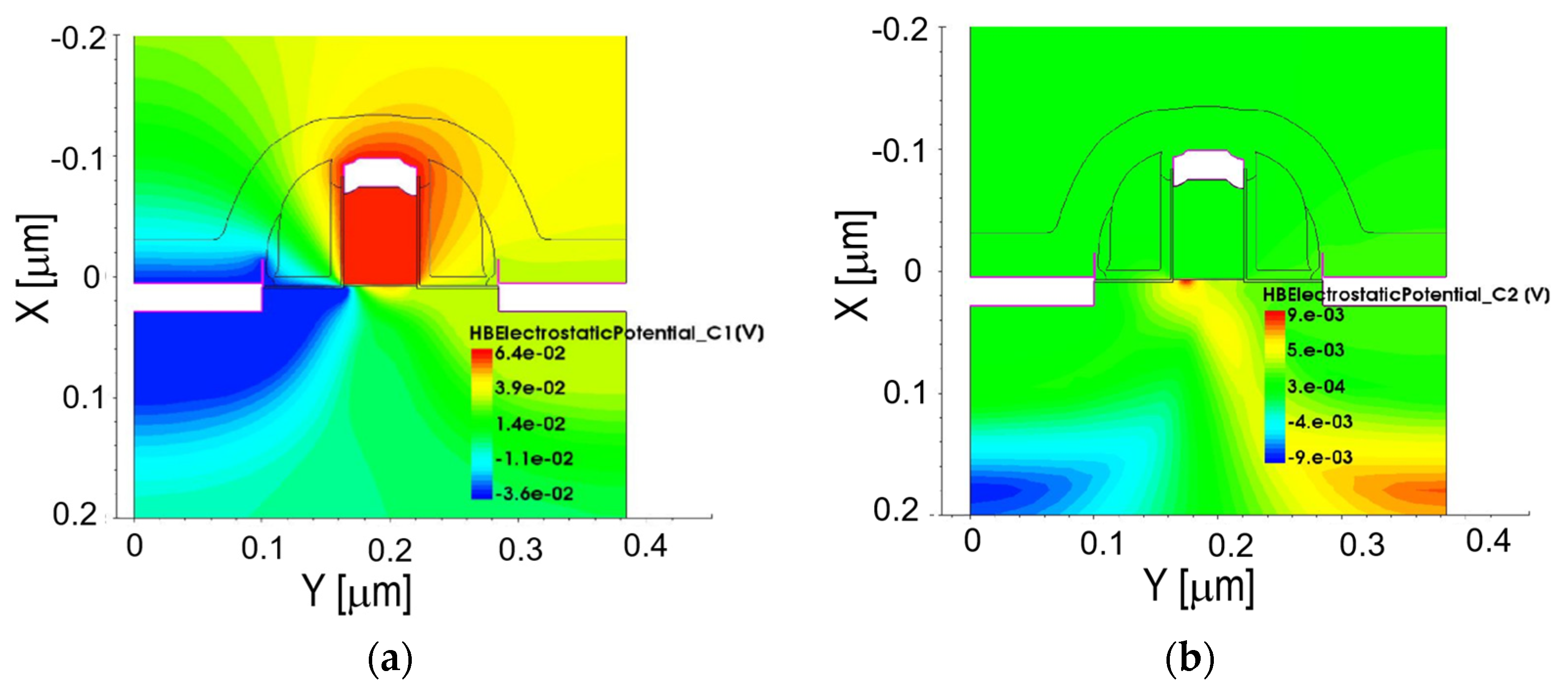

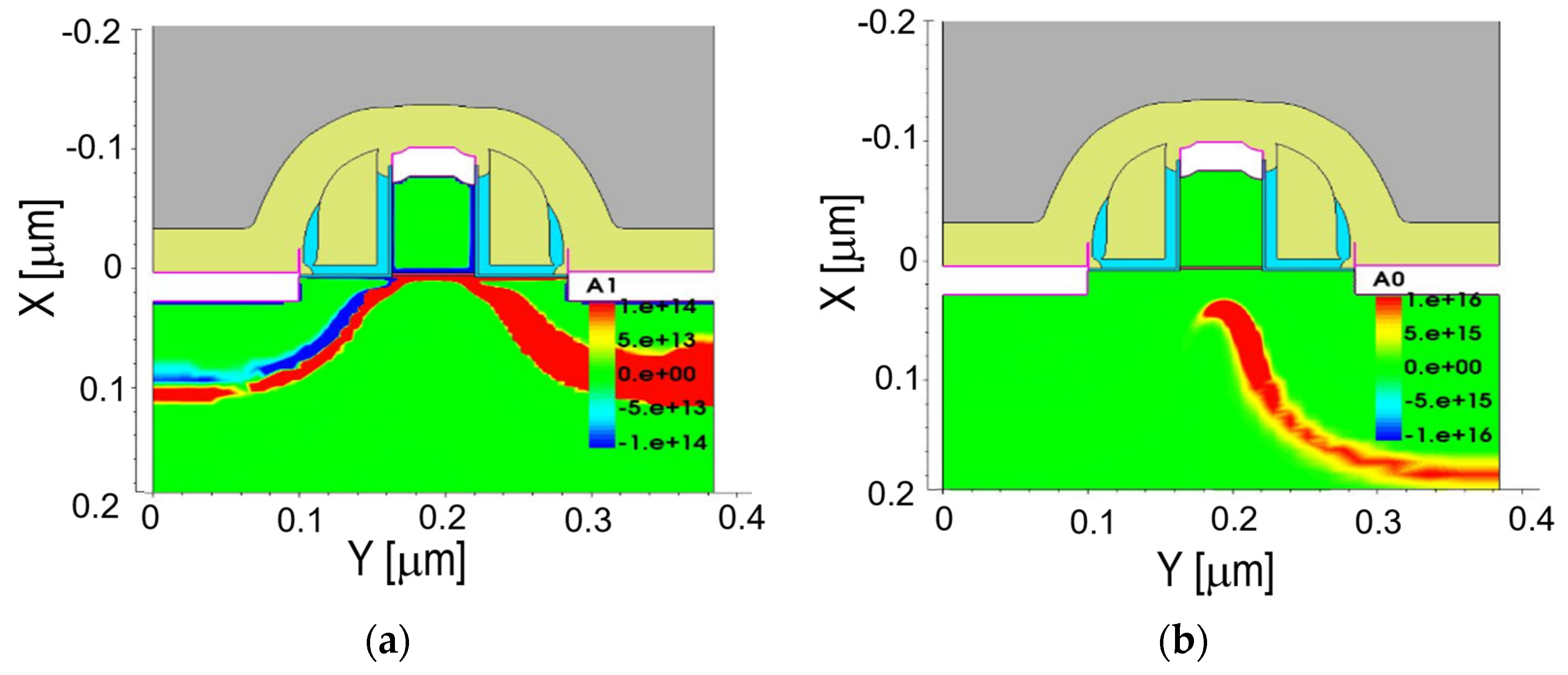
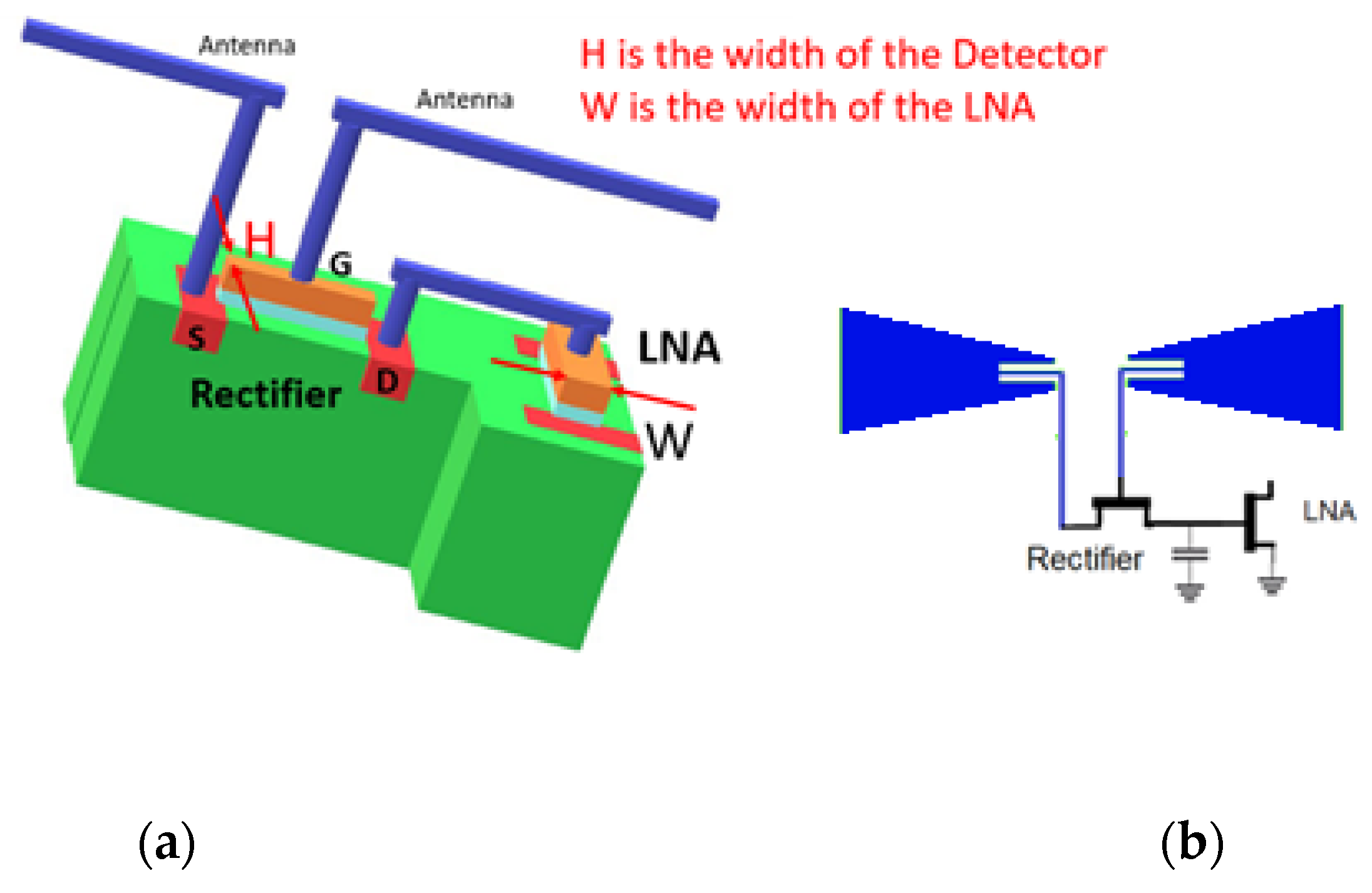

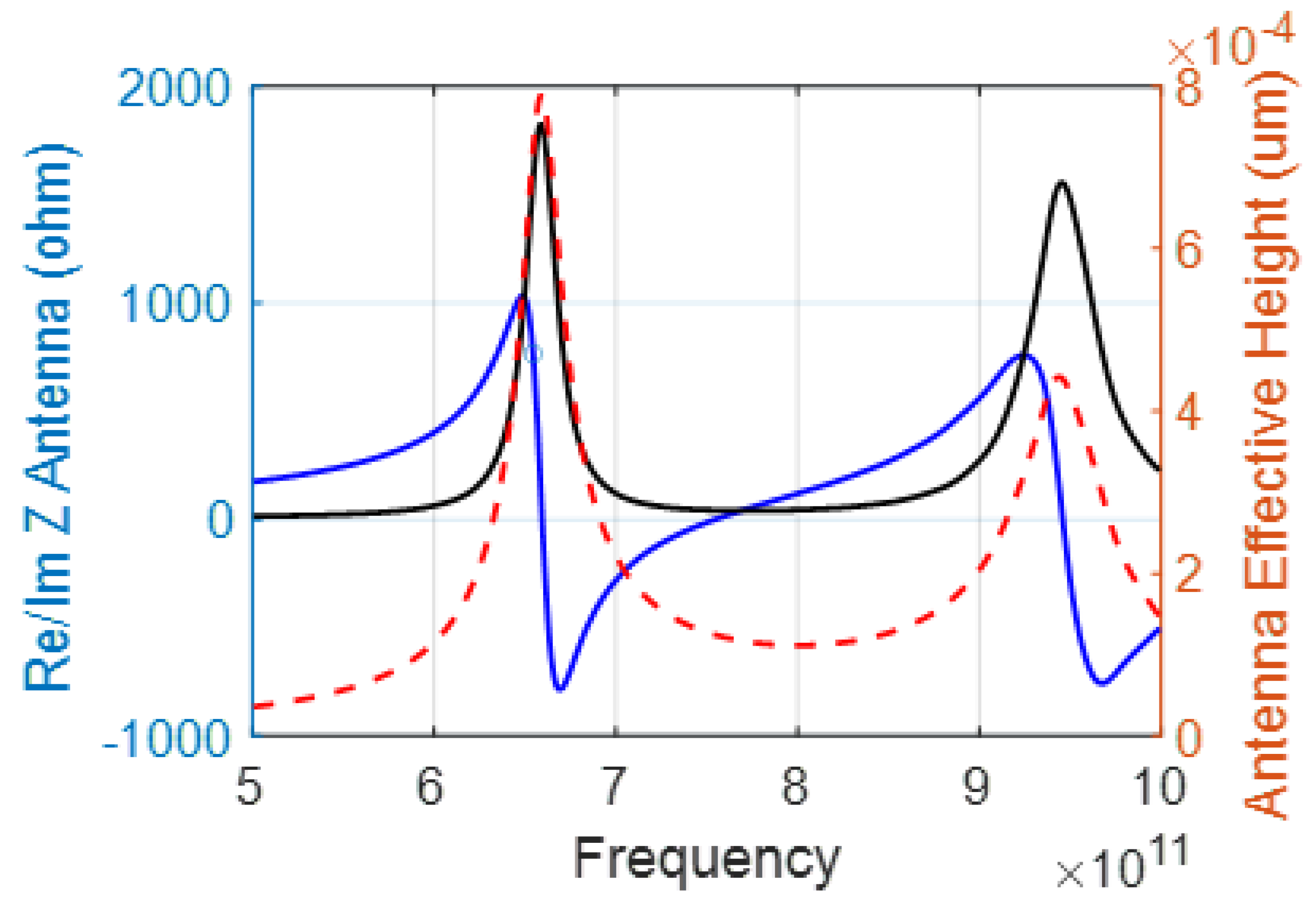

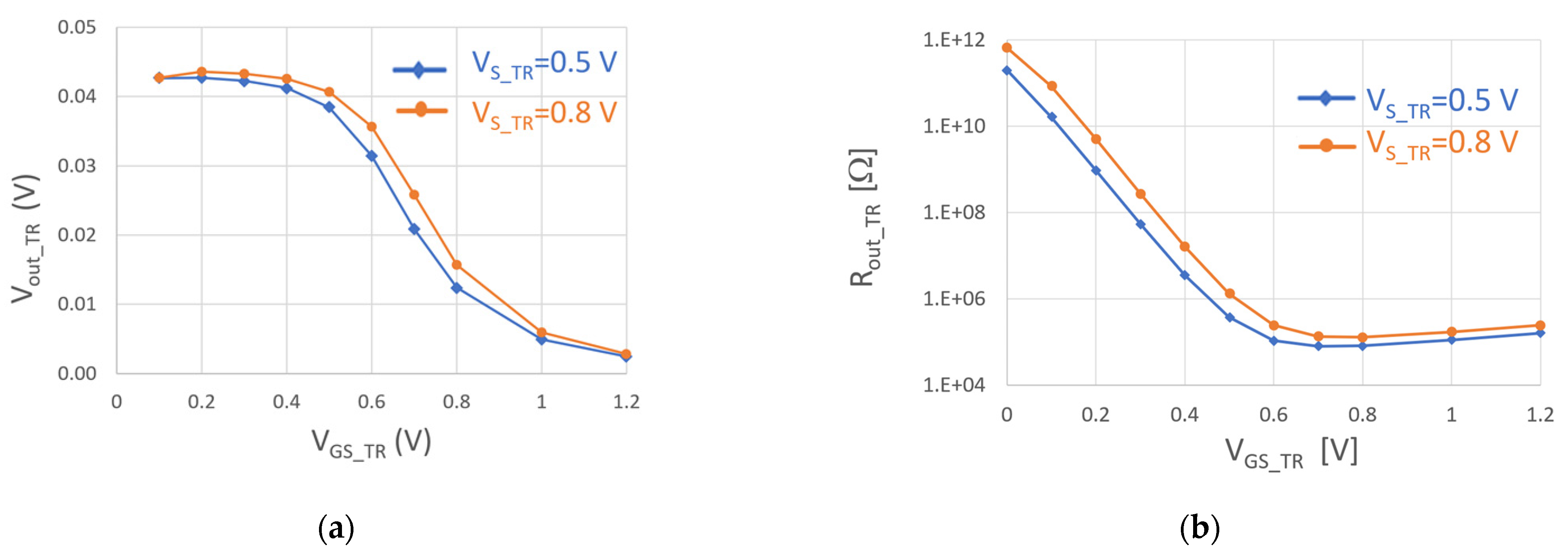


Disclaimer/Publisher’s Note: The statements, opinions and data contained in all publications are solely those of the individual author(s) and contributor(s) and not of MDPI and/or the editor(s). MDPI and/or the editor(s) disclaim responsibility for any injury to people or property resulting from any ideas, methods, instructions or products referred to in the content. |
© 2024 by the authors. Licensee MDPI, Basel, Switzerland. This article is an open access article distributed under the terms and conditions of the Creative Commons Attribution (CC BY) license (https://creativecommons.org/licenses/by/4.0/).
Share and Cite
Palma, F.; Logoteta, D.; Centurelli, F.; Chevalier, P.; Cicchetti, R.; Monsieur, F.; Santini, C.; Testa, O.; Trifiletti, A.; d’Alessandro, A. Design Optimization of a THz Receiver Based on 60 nm Complementary Metal–Oxide–Semiconductor Technology. Electronics 2024, 13, 3122. https://doi.org/10.3390/electronics13163122
Palma F, Logoteta D, Centurelli F, Chevalier P, Cicchetti R, Monsieur F, Santini C, Testa O, Trifiletti A, d’Alessandro A. Design Optimization of a THz Receiver Based on 60 nm Complementary Metal–Oxide–Semiconductor Technology. Electronics. 2024; 13(16):3122. https://doi.org/10.3390/electronics13163122
Chicago/Turabian StylePalma, Fabrizio, Demetrio Logoteta, Francesco Centurelli, Pascal Chevalier, Renato Cicchetti, Frederic Monsieur, Carlo Santini, Orlandino Testa, Alessandro Trifiletti, and Antonio d’Alessandro. 2024. "Design Optimization of a THz Receiver Based on 60 nm Complementary Metal–Oxide–Semiconductor Technology" Electronics 13, no. 16: 3122. https://doi.org/10.3390/electronics13163122






